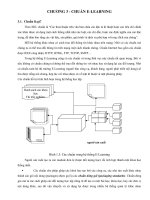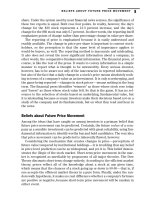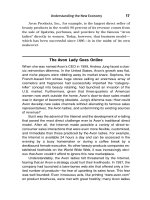Learning portfolio 2 3
Bạn đang xem bản rút gọn của tài liệu. Xem và tải ngay bản đầy đủ của tài liệu tại đây (46.12 KB, 2 trang )
Task 2:
Service organisations should build the right relationships with the right customers. Explain
the four relationship groups identified in reference to a service organisation you are
familiar with.
In order for service organisations to build the right relationships with the right customers,
they classify their customers into one of four relationship groups – according to their
profitability and projected loyalty. Each of these groups requires a different relationship
management strategy.
Th
sh is
ar stu
ed d
v i y re
aC s
o
ou urc
rs e
eH w
er as
o.
co
m
Strangers have a low potential for profitability and little projected loyalty. There is collide
between this kind of customers needs and the company’s offerings – so in order to manage
these customers, business’ should not invest anything in them and try to make money on
every transaction. An example of stranger for Mecca Cosmetica is passer-by who does not
stay, work, or study in the area – however makes a one of impulsive purchase of a
moisturiser.
Butterflies are potentially profitable but not loyal. They is a good fit between their needs and
the companies offerings – however business’ can only enjoy them for a short while until they
disappear. In order to capture the butterfly, business; need to create satisfying and profitable
transactions in order to maximise profits in the short time they buy with the company. After
that, the business should move on and cease investing in them until the next time they
encounter. An example of a butterfly at Mecca Cosmetica is a customer who purchases large
quantities of products for a short time, however since they are constantly seeking out the best
deals without building a regular/loyal relationship, will quickly cease purchasing at Mecca if
other retailers such as Sephora are offering better bargains. They will then flutter from retailer
to retailer.
True friends are both loyal and profitable. There is a strong fit between their needs and the
company’s offerings. The company wants to provide continuous relationship investments to
delight these customers in order to nurture, grow and retain them. Business’ aim to turn true
friends into the true believer – who are customers that come back regularly and tell others
about their positive experiences. An example of a true friend at Mecca Cosmetica is the
customer who lines up at the door when Mecca launches a new product line. They do not care
about the cost or compare the new line to other retailers products, they simply want what
their friend brand has to offer.
Barnacles are highly loyal but not very profitable. There is a limited fit between their needs
and the company’s offerings. They are perhaps the most problematic customers as they create
drag, and business’ should attempt to improve their profitability by selling them more, raising
their fees or reducing service to them. However, if they cannot be made profitable they
should be fired. An example of a barnacle of Mecca Cosmetica is the customer who comes in
a few times a week and purchases a $0.20 face wipe, or just asks for product samples.
This study source was downloaded by 100000824458947 from CourseHero.com on 09-09-2021 06:12:28 GMT -05:00
/>
Task 3:
What factors appear to influence customer adoption of technology-enabled services?
In order for technology enabled services to be successful, customers need to be willing to
adopt an SST. The factors that appear to influence the customer perceived ease of use,
perceived risk, perceived control and perceived fun. This means that in order for customers to
feel comfortable enough to adopt the use of a technology enabled service, they have to be
perceived as better than the alternative, free of risk, controllable, enjoyable and trustworthy.
Th
sh is
ar stu
ed d
v i y re
aC s
o
ou urc
rs e
eH w
er as
o.
co
m
Technology-enabled services’ adoption can also be influenced by a number of individual
differences such as age, gender, income, education, technology anxiety, technology readiness
and the need for human interaction. According to research, this means that people who are
more adoptive tend to be younger, more likely male than female, better educated and paid and
less anxious about using technolgy in general.
This study source was downloaded by 100000824458947 from CourseHero.com on 09-09-2021 06:12:28 GMT -05:00
/>Powered by TCPDF (www.tcpdf.org)









